NOTE: Wildflowers are precious components of biodiversity. For this reason, avoid picking them or harming them in any way, especially those species under threat. Take a picture instead!
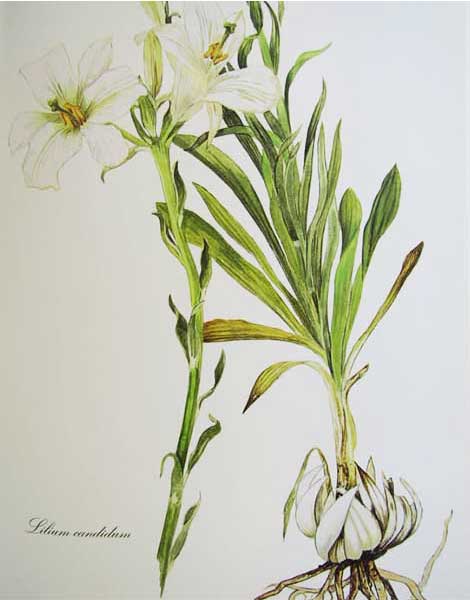
© Illustration by Niki Goulandris from the book "Wild Flowers of Greece", Militos Editions
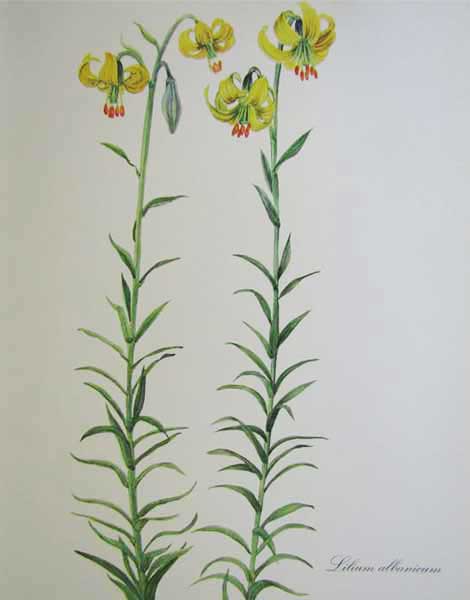
© Illustration by Niki Goulandris from the book "Wild Flowers of Greece", Militos Editions
Ionian Sea: Lilium candidum
This flower, a protected species, is the most famous of the five different Lilium genera found in Greece. It is considered a symbol of the Virgin Mary, which is why its common name is “Madonna Lily.” Its pale white blossoms have long been associated with virtue. The flower has been known since ancient times; depictions of the flower are present on both the “Prince of the Lilies” Minoan fresco at the Palace of Knossos on Crete and the “Spring Fresco” at Akrotiri on the island of Santorini. The plant, which reaches 60-80cm in height, yields an essential oil derived from its flowers that has a strong scent and is used in aromatherapy. Its blooming period is from mid-May to the end of June; you can usually find them in rocky areas with sparse vegetation. They abound among rocky outcrops in the Lefkada mountains, as well as in the ravines in Lasithi, Crete.
Northern Pindos: Lilium albanicum
This species, too, belongs to the Lilium genus, and it’s also a protected species. A mountain lily, it is an impressive bulbous plant with large yellow flowers and a soft aroma reminiscent of honey. It reaches a height of 80cm and blooms between June-July in high meadows and woodland fringes in northern Greece (Epirus, Macedonia) and in the Pindus region, at an elevation between 1450 to 2200 meters – it’s found on the summits of Mts Gramos and Smolikas in the Pindus National Park. The names “krinon” (lily) and “krinonia” (bed of lilies) are often mentioned by the ancient philosopher and father of botany Theophrastus; like many bulbous plants, the Lilium albanicum is considered to have medicinal properties.
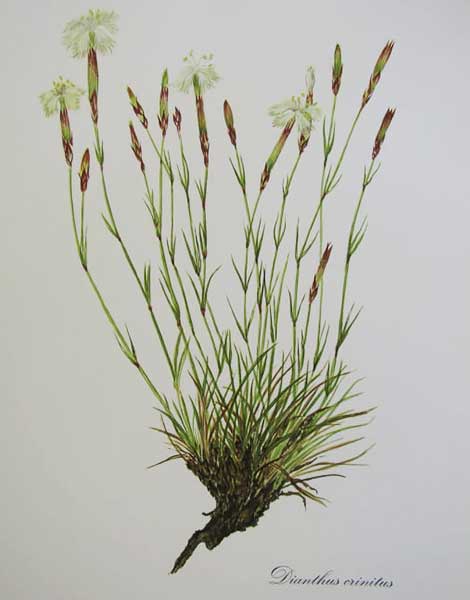
© Illustration by Niki Goulandris from the book "Wild Flowers of Greece", Militos Editions
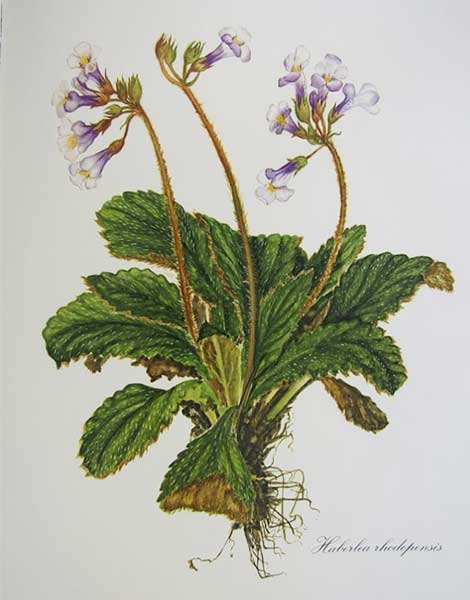
© Illustration by Niki Goulandris from the book "Wild Flowers of Greece", Militos Editions
Eastern Aegean islands: Dianthus crinitus
This is an eastern Mediterranean species which, in Greece, can only be found on Rhodes, and more specifically on the island’s sandy or graveled coastlines or in open pine forests and in dry riverbeds. It is a very beautiful plant, and its unique appearance has earned it the name of “long-haired pink.” Its white or soft pink flowers bloom between April and mid-June.
Eastern Macedonia, Thrace: Haberlea rhodopensis
In Greece, this protected species native to the Balkan area can be found on the mountains of Papikion, Paggaio, Falakro and Menoikon in the Rhodope mountain range near the border with Bulgaria, and at lower elevations in places such as the Nestos Straits, and in shady and damp areas inside rock cracks (mainly limestone) or narrow gorges. Its flowers blossom from April to mid-June. This plant is also cultivated for its beauty, and because it can survive in very low temperatures; it’s commonly used in landscape architecture to add color to rock gardens. It’s also used in the cosmetics industry.
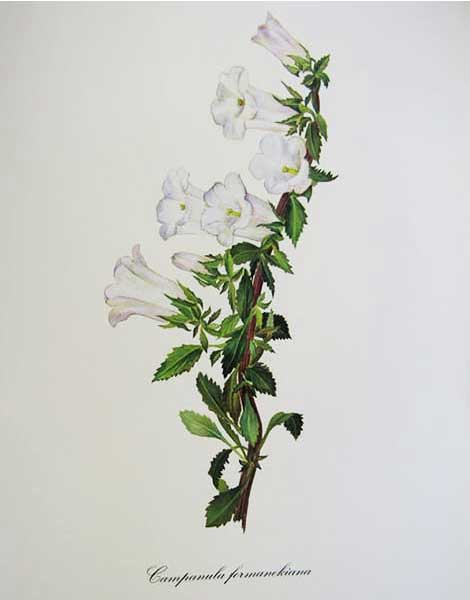
© Illustration by Niki Goulandris from the book "Wild Flowers of Greece", Militos Editions
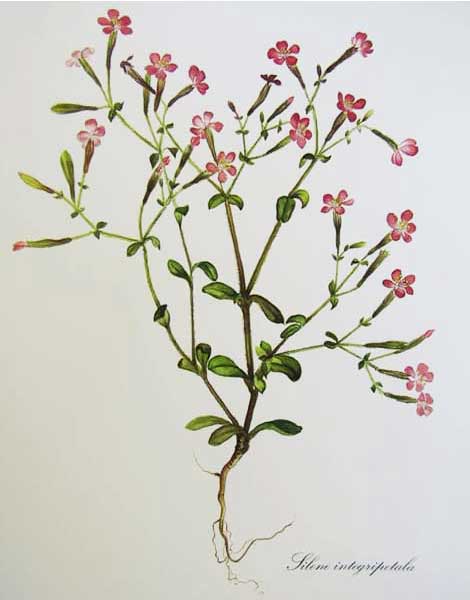
© Illustration by Niki Goulandris from the book "Wild Flowers of Greece", Militos Editions
Evia: Campanula incurva
This endemic plant of Greece is one of the many species belonging to the Campanula genus. Although it is most commonly found in central and northern Evia, the Sporades, Pelion, and the eastern coasts of Thessaly, it has also been spotted on the island of Ikaria. The flowers of this protected species bloom from the end of April to the beginning of June in semi-shady ravines and open forests, as well as on rocks or old stone-built walls. The blossoms can reach 5cm in size and their color ranges from very light blue to soft purple.
Cyclades: Pancratium maritimum
This bulbous plant grows on the sandy shores of the Mediterranean and Black seas. It is known for its large fragrant white blooms that release a unique aroma into the summer night air. Its flowers can be seen covering sand dunes in August in regions where the plant is most common. It’s found in many regions across the country, including on beaches in the Cyclades. Unfortunately, due to over-tourism and unregulated building, the plant’s natural habitat has come under threat and its numbers have started declining in the past few years, a sad fate indeed for a plant depicted in frescoes from the Late Cycladic period on Santorini, as well as in murals in the Palace of Knossos on Crete.
Peloponnese: Silene integripetala
The pink flowers and the shoots of the sparsely branched Silene integripetala appear from March until June. This plant usually grows at low elevations but, being a highly adaptable plant, it can on rare occasions be found at elevations reaching up to 1900m. You’ll see it on riverbanks, on the edges of roads, in open wooded areas and on rocky limestone slopes. The plant reaches up to 25cm in height. Although the original Silene integripetala is endemic to the south of the Peloponnese, you can find subspecies of it on the island of Elafonisos and in southern Crete.
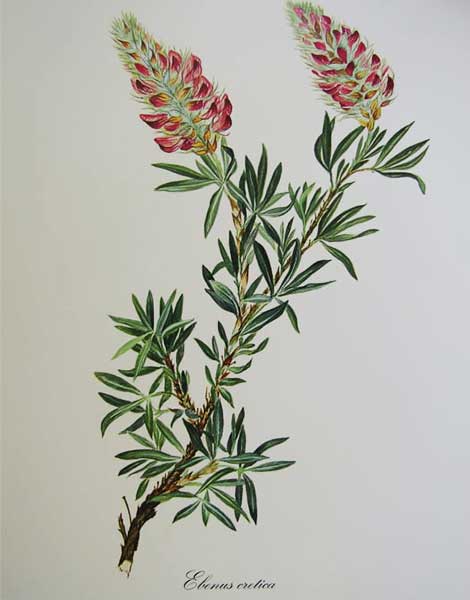
© Illustration by Niki Goulandris from the book "Wild Flowers of Greece", Militos Editions
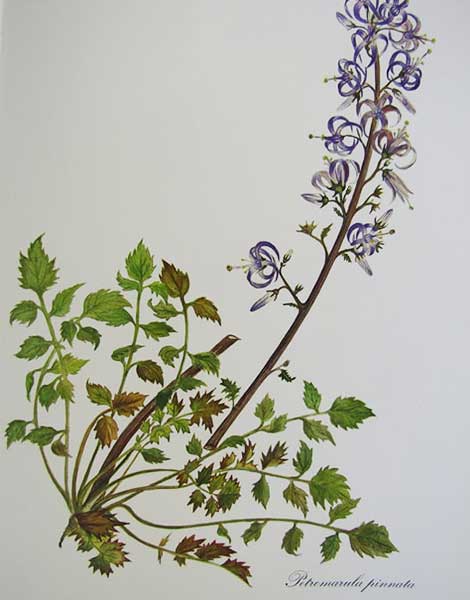
© Illustration by Niki Goulandris from the book "Wild Flowers of Greece", Militos Editions
Crete: Ebenus cretica
The Cretan ebony bears different names across different regions of Crete, including “archontoxilo,” “ploumi,” and “alimatsa.” It is a subshrub – a plant with ground-hugging stems – that can reach a height of up to one meter. Its leaves are furry and its flowers, an intense pink-fuschia color, bloom in dense bunches around a central axis, from April to the beginning of June, depending on their location and altitude. Its petals are said to be used to fill pillows and mattresses. It is an endemic plant of Crete – meaning that it naturally grows there exclusively – and is very common in a few areas, where it’s found in great numbers. It grows on rocky limestone slopes covered in phrygana, and on roadsides at elevations that reach 1100m.
Crete: Petromarula pinnata
This plant, endemic to Crete, is considered very important because it’s the only representative of its genus. It belongs to the Campanulaceae family and the name Petromarula comes from the words petra (rock) and marouli (lettuce). Its toothed leaves form a rosette at their base; its soft purple flowers appear from April to June and develop into dense bunches around a central axis. It’s a chasmophyte, meaning it grows exclusively inside cracks in rocks, on limestone surfaces, and on old stone walls, at elevations ranging from the lowlands to mountainous areas.
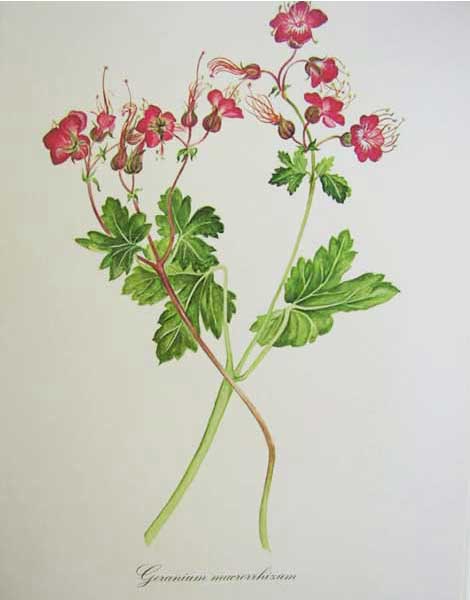
© Illustration by Niki Goulandris from the book "Wild Flowers of Greece", Militos Editions

© Illustration by Niki Goulandris from the book "Wild Flowers of Greece", Militos Editions
Evia: Geranium macrorrhizum
This may well be the most beautiful of geraniums. It is a long-lasting plant with large pink or purple flowers, long stems and a strong smell. You can find it mainly in rocky areas at elevations ranging from 750m to 2000m – although, on rare occasions, you may find it at elevations as low as 100m. Found in Evia as well as many regions of northern Greece, it blossoms from June to August and belongs to the Geraniaceae family.
Mt Olympus: Jancaea heldreichii
Mt Olympus is of great botanical interest throughout the whole year, as it plays host to around 1700 plant species. One of the most important ones, endemic to the region, is the herbaceous protected species Jancaea heldreichii. A long-lasting plant, it is the only representative of the Jancaea genus belonging to the Gesneriaceae family. Its leaves grow at its base and its small flowers look like small bells. It blossoms from May to August and can be found alongside streams, including the Urlias, the Papa, the Xerolaki and the Enipeas, in ravines and in limestone rock cracks, at elevations ranging from 400m to 1400m.
We would like to thank biologist and researcher Andreas Zikos, who deals with issues related to Mediterranean ecosystem ecology and Greek flora, for the information that he shared with us. Note: These are summer wildflowers, meaning they can be found roughly between May and September.











